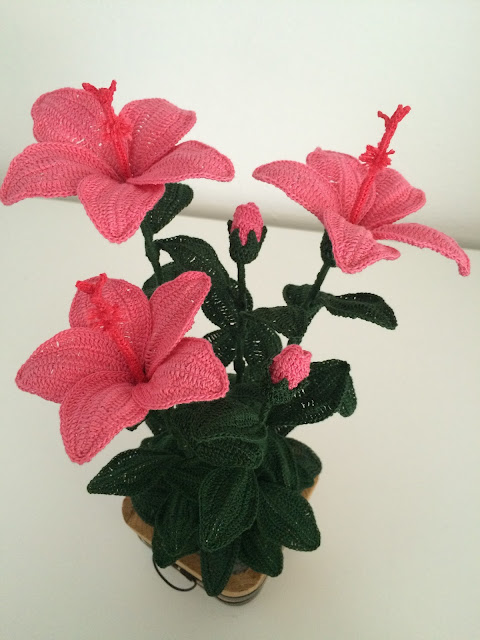Explanation of the first part of the crochet undergrowth
Explanation of wild anemone
Walking through the woods it is not uncommon to encounter many colorful spots that dot the soft green carpet of the undergrowth.
Wild anemone is a small spontaneous plant that lives well in shady areas under large trees.
The wild anemone is the first plant that is part of the crochet undergrowth.
To make the crocheted wild anemone, prepare: the flower, the pistil and the bud.
Needed: cotton number 20 - 1.0mm crochet hook - scissors - plasticized iron wire - pliers.
Explanation of the flower
Start 2 chains and in the first do 8 single crochet in total.
1st round: 2 double crochet at one point. Turn the job around.
2nd round: 2 double crochet at one point for 2 times. Turn the job around.
3rd round: half double crochet. A double crochet and a triple crochet at a point. A triple crochet and a double crochet in a point. A half double crochet. Descend with slip stitch until the beginning of the petal. A slip stitch in the next point and repeat the same for a total of 8 petals.
Explanation of the pistil
Start 5 chains and close them in a circle.
1st round: 7 chains, one single crochet. Repeat the same for a total of 12 bows.
Cut a piece of plasticized iron wire of the length and thickness appropriate to the work being carried out. On a point wrap cotton more times (match the color according to the shade of the petals). Bend the tip of the stem with the aid of pliers to block the work.
Put the pistil in order and then the flower. It does not need a glass. Cover the stem with the cotton, working the chains around it, except for about 3 cm, which should be inserted into the vase.
Explanation of the bud
Start 4 chains and in the first make 9 double crochet (total 10).
1st round: 10 double crochet. Cut a piece of plasticized wire and bend a point twice to form a knot. Insert it into the bud and close the first round.
2nd round: 2 double crochet closed together for the whole lap.
3rd round: 2-3 slip stitch and close the job.
It does not need a glass. Cover the stem with the cotton, working the chains around it, except for about 3 cm, which should be inserted into the vase.
Explanation of the navel of Venus
A humble yet useful plant that we often find in the countryside and in dry stone walls where it finds the right humidity.
To make the navel of Venus crochet it is necessary to prepare the leaves which are of 3 different sizes.
Needed: cotton number 20 - crochet 1.0mm - scissors - galvanized iron wire 0.45mm.
Explanation of the large leaf
Start 4 chains and in the first make 11 double crochet (total 12).
1st round: 24 double crochet.
2nd round: 36 double crochet (increase every 2 points).
3rd round: 54 double crochet (increase every 2 points). Close the job.
Cut about 10 cm of galvanized iron wire and place it in the center of the 12 initial double crochet. Make it come out from underneath and twist it on itself to form a small stem. Cover this cotton shank by working the chains around it except for about 2 cm that will be inserted into the vase.
Explanation of the medium leaf
The same procedure as for the big leaf by working one lap less.
Explanation of the small leaf
Same procedure as the medium leaf, working one less lap.
Explanation of the dry leaf
They seem useless but, in addition to coloring our autumn, the dry leaves create the ideal habitat for so many little creatures that nourish the soil.
Needed: cotton number 20 - crochet 1.0mm - scissors.
Explanation of the leaf
Start 20 chains.
1st round: 3 single crochet, 3 half double crochet, 7 double crochet, 3 half double crochet, 3 single crochet. Repeat the same on the other side of the chains.
2nd round: same as the first round. There are 3 increases arranged in the 3 central points of the 7 high points.
3rd round: 3 low points. A low point, 3 chains and a low point in a point.
Repeat the same way around the leaf. At the end of the round do 6 chains and in these do 5 low points.
The wild anemone seedling can be assembled separately in a vase along with a few blades of grass and a dry leaf. The navel of Venus can be placed in a vase with stones and a little bit of grass. Or wait to have all the elements and thus create your personal undergrowth.
I hope as always to have explained everything to the best and I wish you good creation.
Hi everyone, see you next time.












Per favore in italiano. Brava
RispondiEliminaCiao, grazie per i complimenti. Ti invio i link della spiegazione completa del sottobosco: https://shorturl.at/kpkBW
Elimina